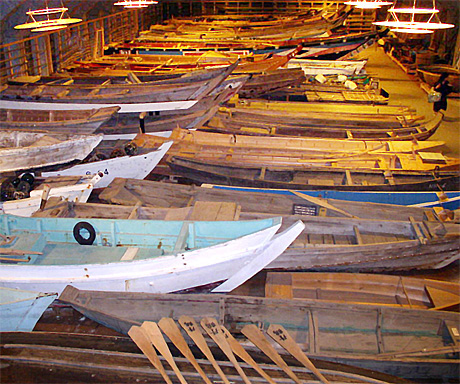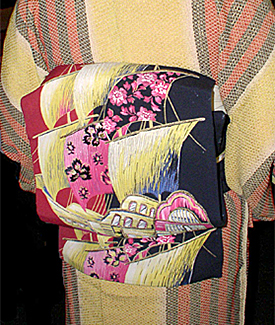
Changes
23 March 2007
By Michelle Damian
After three weeks of being a sponge and trying to absorb everything that was thrown at me, I'm now back in the USA mostly recovered from jetlag and trying to make some semblance of order out of all this new information. The trip was incredibly informative; I ended every day saying "I've learned so much!" It helped tremendously to actually see many of the examples of wooden boats built in traditional styles. Now it comes time to wring out the sponge and see what I can apply to this study.

Be careful what you wish for: Michelle went to Japan to study Japanese wooden boats and got her heart's desire!
Sometimes there was definitely a sense of information overload. It began to be difficult to separate "things I'm paying attention to for my thesis" and "anything else to do with Japanese boats." I knew the final straw had been reached on my last full day in Japan, when I went out to lunch with some friends at a restaurant in Nara. I asked the proprietor if she'd mind if I took her picture… because the obi (belt) of her kimono had a boat depicted on it. That's it, it's time for me to finish up here!

Obi with embroidered sailing vessel.
All joking aside, it was an incredibly fruitful trip. I have an entire shelf full of books, pamphlets, and brochures that I will need to plunge into, nearly a thousand photographs to compare with all the woodblock prints, videos of an interview with a shipwright, and even a few model boats and ro to work with. Some of the meetings I had were a bit daunting, particularly when one maritime historian told me that the woodblock prints were "next to useless" in considering construction techniques. While after seeing some actual examples of Edo-period ship construction I can see discrepancies in the artistic renditions, I hesitate to dismiss outright everything the woodblock prints depict.

All of the materials Michelle brought back from Japan: her work is cut out for her.
That brings me to what I think the next phase of the thesis is going to be. I'd begun this project by proposing to look at "construction techniques and uses" of Japanese boats as seen in the prints. I think that this will become more of a critique of the accuracy of the prints, looking more at what one can and can't learn from the prints alone. The artists did focus on the details of the boats but by and large they were not shipwrights or sailors and perhaps did not fully understand vessel construction.

Words to remember when doing research (Photo by Dr. David Stewart).
I mentioned this new direction to one of the professors on my thesis committee, and he laughed and pulled out a photograph he took while doing his own dissertation research. It was a simple roadsign, saying only "Changed Priorities Ahead." As research progresses, new questions arise and new problems present themselves. The trick now will be reconciling those new issues with the original hypotheses I had envisioned in presenting the thesis prospectus. Changed priorities perhaps, but the end goal of further understanding Japanese wooden vessels remains intact.
As always please feel free to contact me at muaprojectjournal@yahoo.com with any comments, questions, or suggestions during the weeks to come. Yoroshiku onegai shimasu ("I look forward to your good favor").
Return to Project Journal home page.

